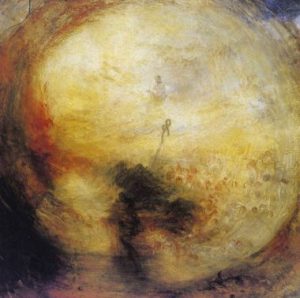J. M. W. Turner was a Romantic artist who lived during the Industrial Revolution. Best known for the beauty of his turbulent, expressive landscapes, he was a forerunner of different following art movements, such as Impressionism.

Image source: https://www.wikiart.org/en/william-turner/the-wreck-of-a-transport-ship
He was fascinated by the Romantic ideal of the Sublime in nature, a force shown in terrifying, suggestive natural events: shipwrecks, eruptions, storms are protagonists of his artworks.
Early career

Image source:https://commons.wikimedia.org/wiki/File:Joseph_Mallord_William_Turner_auto-retrato.jpg
J. M. W. Turner was born in 1775, in a middle-class family in Covent Garden. Brilliant and talented, he was admitted to the Royal Academy at 14 years old. This was a rich intellectual environment, and Turner was very interested in scientific lectures about new discoveries. In 1796, Turner exhibited for the first time in the Royal Academy one of his oil paintings: “Fisherman at Sea”. In this nocturnal moonlit scene, he shows his mastery of the light, which is the real protagonist in the canvas. This artwork, praised by the critic, founded his reputation as a landscape painter.
Romanticism and Industrial Revolution
Romantic ideals were based on the rejection of Rationalism and Classicism, ideals that failed with the French Revolution and the Restoration. Classical aesthetic canon was fading in art, too. The Romantic artist wants to free-express his feelings, without any kind of objective representation criteria. For the same reason, he is alone and in contrast with society.

Image source: https://commons.wikimedia.org/wiki/File:Rain_Steam_and_Speed_the_Great_Western_Railway.jpg
Turner lived during the English Industrial Revolution: in that period ancients and gods were substituted by science and technology. Steam is the symbol of the future and a key element in Turner’s paintings. In “The Fighting Temeraire, tugged to her last berth to be broken up”, the warship Temeraire is pulled by a small steam-tug, toward her last trip before dismantling. Past is pulled by the propulsive force of steam. In “Rain, Steam, and Speed – The Great Western Railway”, one of his later artworks, Turner represents the explosive power of the future: a train at full speed on the Maidenhead Railway Bridge.
The Sublime

Image source: https://www.wikiart.org/en/william-turner/mount-vesuvius-in-eruption-1817
The Sublime is a crucial theme in Turner’s landscapes. It was theorized by Burke as a feeling of fear and rejection in front of the magnificence of nature, capable of showing the fragility of humankind, and a kind of charm at the same time. The Sublime shows up in all his strength, such as in “Eruption of the Vesuvius”, and is captured by Turner with his fire red explosion. Turner’s artworks are not confined to the representation of Sublime in landscapes, but he underlines the works of human genius. The painter suggests in his artworks that progress and inventions are the only way to fight the devastating strength of nature, the Bell Rock lighthouse, for instance; this lighthouse is an example of engineering work created to resist the impact of strong, stormy waves, represented in the homonymous painting work.
Heritage
Turner dying words, on 19 December 1851, were “The Sun is God”. This sentence contains his pictorial lesson, which revolves around the mastery of light and color. It does not concern only the Sublime, but the overcoming of objective representation of phenomena. Moreover, he wants to abstract from context, creating a rarefied and dreamlike atmosphere, characterized by pure chromatism and lights, not forms. The maximum expression of this aesthetic is “Light and Colour (Goethe’s Theory)”. We are moving towards a new form of representation, which goes beyond the phenomenal appearance, to express personal and intimate emotion. Turner’s heritage will be taken up by the impressionist aesthetic some decades later.

Info sources:
https://en.wikipedia.org/wiki/J._M._W._Turner
https://www.wikiart.org/en/william-turner
https://www.william-turner.org/
https://www.bbc.co.uk/arts/multimedia/turner/
